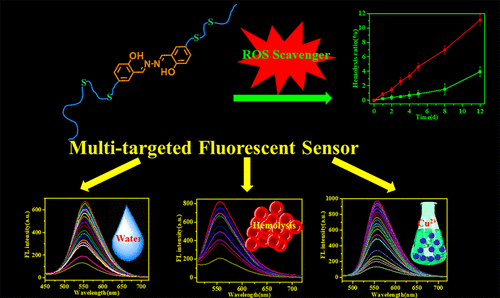当前位置:
X-MOL 学术
›
ACS Appl. Mater. Interfaces
›
论文详情
Our official English website, www.x-mol.net, welcomes your
feedback! (Note: you will need to create a separate account there.)
Aggregation-Induced Emission-Active Fluorescent Polymer: Multi-Targeted Sensor and ROS Scavenger
ACS Applied Materials & Interfaces ( IF 8.3 ) Pub Date : 2021-01-22 , DOI: 10.1021/acsami.0c22698 Herong Qin 1 , Jianbing Huang 1 , Hui Liang 1 , Jiang Lu 1
ACS Applied Materials & Interfaces ( IF 8.3 ) Pub Date : 2021-01-22 , DOI: 10.1021/acsami.0c22698 Herong Qin 1 , Jianbing Huang 1 , Hui Liang 1 , Jiang Lu 1
Affiliation

|
A multi-functional polymer with aggregation-induced emission (AIE)-active salicylaldehyde azine (SA) functionality and reactive oxygen species (ROS)-responsive thioether groups is readily prepared via thiol-ene click polymerization of SA derivative diacrylate monomer, poly(ethylene glycol) diacrylate, and 3,6-dioxa-1,8-octanedithiol. The obtained AIE-active polymer exhibited an unexpected strong emission in amide solvents compared to that in other common organic solvents that was dramatically decreased by adding a trace amount of water, suggesting that the polymer could be utilized as a water trace indicator in amide solvents. In the backbone, the PEG segments make the polymer well dispersed in water and the ROS-responsive thioether groups enable this polymer as a promising ROS scavenger, with embedded SA moieties as a fluorescent indicator for the hemolysis determination. Due to the ability of SA moieties to complex with Cu2+, this AIE polymer can also be utilized as a fluorescent sensor for selective Cu2+ detection in real-world water samples. Thus, this multi-functional polymer is anticipated to be well applied in biological and environmental applications.
中文翻译:

聚集诱导的发射活性荧光聚合物:多目标传感器和ROS清除剂
通过以下方法可以轻松制备具有聚集诱导发射(AIE)-活性水杨醛嗪(SA)官能团和活性氧(ROS)-响应性硫醚基团的多功能聚合物。SA衍生物二丙烯酸酯单体,聚乙二醇二丙烯酸酯和3,6-dioxa-1,8-octanedithiol的硫醇-烯点击聚合。与其他常见有机溶剂相比,所获得的AIE活性聚合物在酰胺溶剂中表现出出乎意料的强发射,通过添加痕量水可显着降低其发射,这表明该聚合物可用作酰胺溶剂中的水痕量指示剂。在主链中,PEG链段使聚合物充分分散在水中,并且ROS响应性硫醚基使该聚合物成为有希望的ROS清除剂,其中嵌入的SA部分作为溶血测定的荧光指示剂。由于SA部分能够与Cu 2+络合,因此该AIE聚合物还可以用作选择性Cu的荧光传感器。实际水样中的2+检测。因此,预期该多功能聚合物将很好地应用于生物学和环境应用。
更新日期:2021-02-03
中文翻译:

聚集诱导的发射活性荧光聚合物:多目标传感器和ROS清除剂
通过以下方法可以轻松制备具有聚集诱导发射(AIE)-活性水杨醛嗪(SA)官能团和活性氧(ROS)-响应性硫醚基团的多功能聚合物。SA衍生物二丙烯酸酯单体,聚乙二醇二丙烯酸酯和3,6-dioxa-1,8-octanedithiol的硫醇-烯点击聚合。与其他常见有机溶剂相比,所获得的AIE活性聚合物在酰胺溶剂中表现出出乎意料的强发射,通过添加痕量水可显着降低其发射,这表明该聚合物可用作酰胺溶剂中的水痕量指示剂。在主链中,PEG链段使聚合物充分分散在水中,并且ROS响应性硫醚基使该聚合物成为有希望的ROS清除剂,其中嵌入的SA部分作为溶血测定的荧光指示剂。由于SA部分能够与Cu 2+络合,因此该AIE聚合物还可以用作选择性Cu的荧光传感器。实际水样中的2+检测。因此,预期该多功能聚合物将很好地应用于生物学和环境应用。











































 京公网安备 11010802027423号
京公网安备 11010802027423号